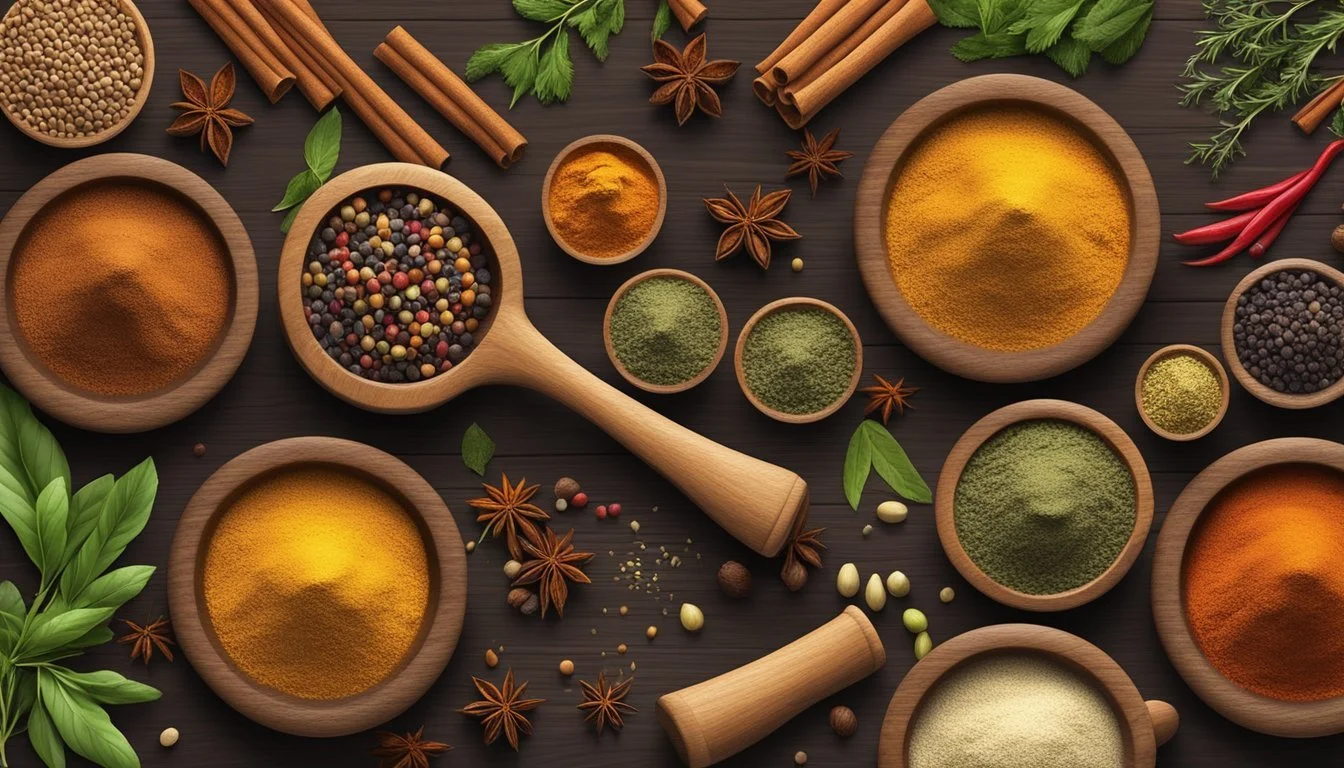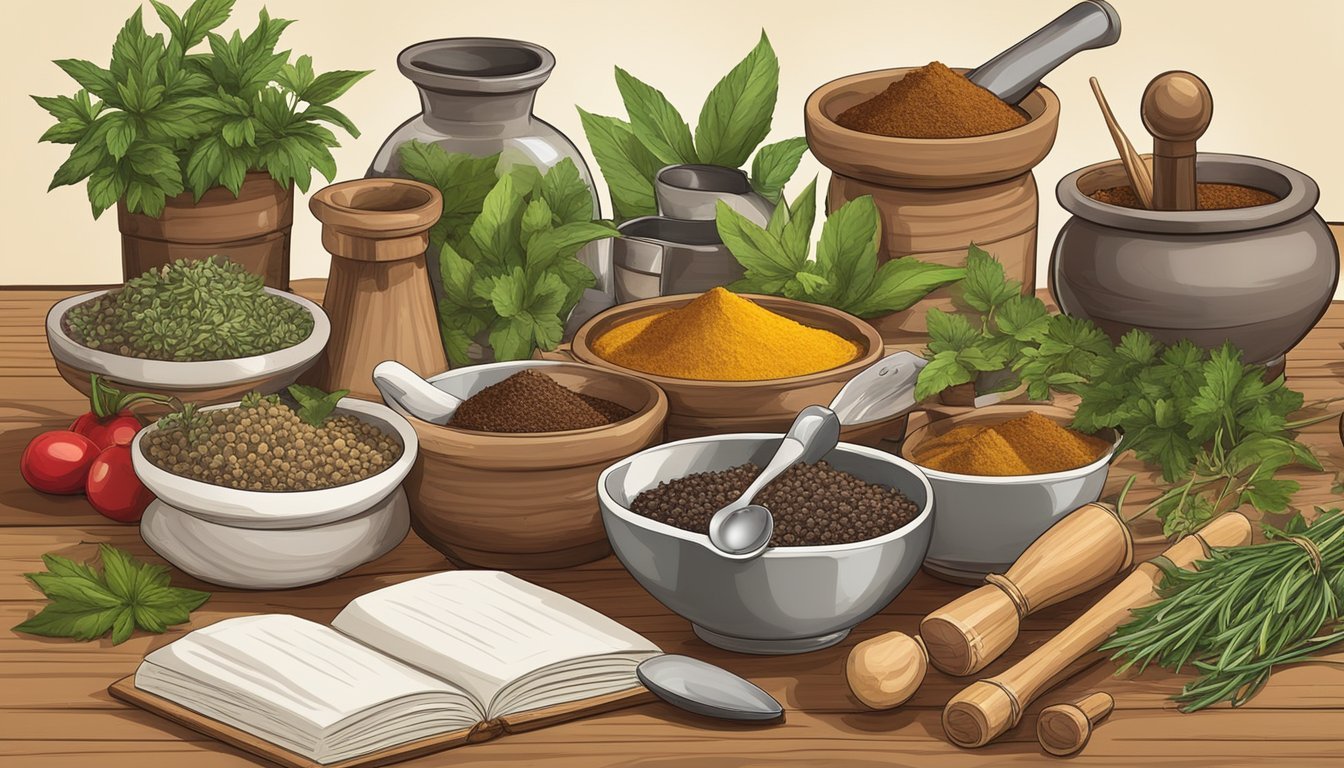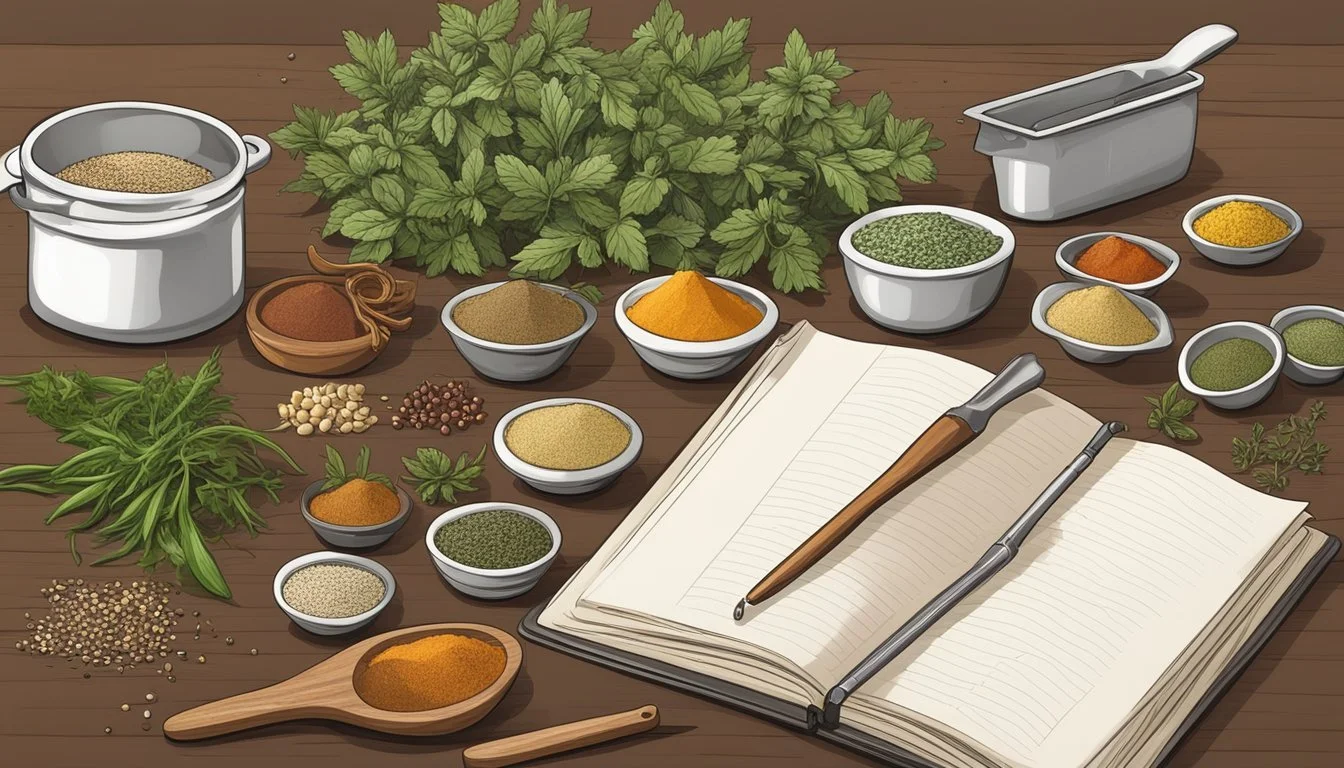How to Create Custom Spice Mixes for Any Cuisine
A Step-by-Step Guide
Creating custom spice mixes is an essential skill that transforms ordinary meals into extraordinary culinary experiences. Tailoring a blend to complement a specific cuisine not only enhances flavor but also provides an easy way to incorporate a variety of spices that define regional taste profiles. Home cooks and professional chefs alike can explore the art of spice mixing— from the earthy tones suitable for a hearty stew to the aromatic essences perfect for a light and fragrant curry.
Understanding the function of each spice within a blend is as important as the spices themselves. Spices can compliment or contrast with each other, providing warmth, heat, sweetness, or earthiness. The process begins by selecting quality spices, considering factors such as freshness and origin for the best flavor payoff. Then it's about experimentation and balance—combining these components to achieve a harmonious and versatile seasoning that can elevate the simplest ingredients.
The craft of making custom spice blends offers a personal touch to any cuisine and invites creativity in the kitchen. It allows one to embrace the flavors of a particular region or to merge different culinary traditions into one's cooking. Whether sprinkled on roasted vegetables, rubbed onto meats before grilling, or stirred into sauces and soups, these spice mixes become a secret weapon for anyone looking to impress with their culinary flair.
Understanding Spices and Herbs
Creating custom spice mixes starts with a comprehensive understanding of spices and herbs, their unique flavor profiles, and their applications across different cuisines.
Core Components of Flavor Profiles
Flavor profiles are the foundation of any spice mix, and understanding the base flavors is crucial. The five core taste components—sweetness, sourness, saltiness, bitterness, and umami—can all be manipulated through the use of various spices. For instance:
Sweetness is often introduced with spices like cinnamon or nutmeg.
Sourness can be accentuated with sumac or amchur (dried mango powder).
Saltiness is direct, but spices like celery seed can impart a salty note without actual salt.
Bitterness can be provided through fenugreek or mustard seeds.
Umami, the savory depth, can be enhanced with dried mushrooms or tomato powder.
Common Spices in Varied Cuisines
Different cuisines emphasize different spices to achieve their signature aromas and taste:
Italian: Basil, oregano, and rosemary
Indian: Turmeric, cumin, and cardamom
Middle Eastern: Za'atar, cumin, and coriander
Latin American: Chili powder, cumin, and oregano
Asian: Star anise, Szechuan peppercorn, and ginger
These are merely a few examples, each cuisine has a rich tapestry of spices that define its character.
The Role of Herbs in Seasoning
Herbs play an equally critical role in seasoning and are primarily used for their aromatic properties. They can be divided into two categories based on their flavor intensity:
Soft herbs: These include basil, cilantro, and parsley, which are often added towards the end of the cooking process or used fresh to maintain their delicate flavor.
Hard herbs: Such as rosemary, thyme, and bay leaves, which have more robust flavors and are used in the earlier stages of cooking to allow their flavors to develop and infuse into the dish.
Herbs add complexity and a fresh dimension to spice mixes, elevating the overall flavor profile of a dish.
Essentials of Spice Blend Creation
Creating custom spice blends involves a meticulous selection of spices, balance of flavors, and consideration of textures and colors. This section will guide the reader through these fundamental steps.
Selecting Your Core Spices
When starting a custom spice blend, one must choose core spices carefully. They will form the backbone of your blend. For instance, cumin adds a warm and earthy base, while paprika contributes a sweet and smoky undertone. Oregano provides a robust herbal note essential for many Italian and Mediterranean dishes. It's crucial to include spices that complement the cuisine you're targeting.
Balancing Flavors
A well-rounded spice blend achieves a harmony of flavors. It's important to balance the five basic tastes: sweet, salty, sour, bitter, and umami. For example, cumin, with its earthy notes, balances well with the subtle bitterness of oregano and the mild sweetness of paprika. One may adjust quantities or add additional spices until the desired balance is achieved, being careful not to let one flavor overpower the others.
Considering Texture and Color
The appeal of a spice blend isn't just in its taste; texture and color also play significant roles. A mix of whole and ground spices adds varied texture to the blend, offering both immediate and gradual flavor release. Additionally, the vibrant red of paprika can add a tempting color to the blend, enhancing not just flavor but also the visual appeal of a dish. A spice mix should be a feast for the eyes as well as the palate.
Creating Cuisine-Specific Spice Mixes
Crafting custom spice mixes tailored to specific cuisines enhances dishes by adding authentic and nuanced flavors. A chef can elevate their cooking by understanding the key ingredients that define the spice profiles for various cuisines such as Mexican, Italian, Indian, and Mediterranean.
Crafting the Perfect Taco Seasoning
To achieve authentic Mexican flavors in a taco seasoning blend, one must incorporate ground cumin, chili powder, and smoked paprika. The balance of heat and earthiness is crucial. A simple recipe could include:
1 tbsp chili powder
1 tsp ground cumin
1 tsp garlic powder
1/2 tsp onion powder
1/2 tsp smoked paprika
1/4 tsp oregano
1/4 tsp salt
1/4 tsp black pepper
Exploring Italian Seasoning Combinations
Italian seasoning relies heavily on herbs such as basil, thyme, oregano, rosemary, and marjoram. Together, they capture the essence of Italian cuisine. Mix the following to store and use with Italian dishes:
1 tbsp dried basil
1 tbsp dried oregano
1 tbsp dried rosemary
1 tbsp dried thyme
1 tbsp dried marjoram or sage
Concocting Aromatic Garam Masala
Garam Masala, a cornerstone in Indian cuisine, consists of warmer spices that deliver a rich, aromatic flavor. A blend might feature:
2 tbsp coriander seeds
1 tbsp cumin seeds
1 tbsp cardamom seeds
1 tbsp black peppercorns
2 cinnamon sticks
1 tsp whole cloves
1 tsp nutmeg (grated) These spices are typically toasted and ground to release their fragrant oils.
Developing Vibrant Mediterranean Blends
Incorporating a blend similar to Herbes de Provence brings the Mediterranean palate to life. This might include dried lavender, fennel (how long does fennel last?), basil, and thyme. Such blends are essential for replicating the fresh and zesty flavors characteristic of the region. A simple mix:
1 tbsp dried thyme
1 tbsp dried rosemary
1 tbsp dried basil
1 tbsp dried sage
1 tsp dried lavender (optional, but adds uniqueness)
Each spice mix should be adjusted according to the chef's palate and the specific dish's requirements, allowing for a fully customized flavor profile.
The Practicalities of Spice Mixing
The creation of custom spice mixes involves refining the process from grinding to storage, ensuring optimal freshness and potency. Attention to detail in each step is crucial for a successful blend.
Grinding Techniques for Optimal Freshness
Freshly ground spices provide a more vibrant and robust flavor compared to pre-ground options. Culinary enthusiasts should invest in a spice grinder for consistent results. For optimal freshness, one should grind spices in small, precise batches just before mixing. Different spices may require different grinding techniques; for instance, hard spices like cinnamon sticks often need a more heavy-duty grinder compared to softer seeds such as coriander.
Storage Strategies to Retain Potency
Proper storage is essential to maintain the potency of spice mixes. Spices should be stored away from direct light in airtight containers to minimize exposure to air and moisture. The following table outlines recommended storage techniques:
Spice Type Container Material Storage Location Whole Spices Glass or Ceramic Cool, dark cupboard Ground Spices Metal or Opaque Plastic Dry, low-humidity drawer
Adhering to these strategies will significantly extend the shelf-life of the spice mix.
Measuring and Mixing Protocols
Accurate measuring is crucial for creating a balanced spice mix. Using digital scales is recommended for precision, as it allows for exact proportions and consistency across batches. When mixing, blend spices thoroughly to ensure even distribution of flavors. A step-by-step approach should be followed:
Measure each spice carefully, leveling off measuring spoons for accuracy.
Place all measured spices into a clean, dry bowl.
Stir spices together with a whisk or fork until fully combined.
Transfer the blend to an airtight container immediately to preserve freshness.
By following these protocols, one ensures that every pinch of the spice mix adds the intended flavor to dishes.
Innovating with Custom Spice Blends
Creating custom spice blends is a blend of art and science. It requires a willingness to experiment, knowledge of various spices, and the creativity to pair them effectively. By doing so, one can develop unique flavor profiles that become the signature of any dish they touch.
Experimentation and Unique Pairings
When developing custom spice blends, experimentation is essential. Individuals should consider the color, texture, and flavor of spices to make visually appealing and tasteful combinations. For instance, smoky paprika, when paired with the citrusy tang of sumac, can create a visually striking and flavor-packed blend suitable for meats and veggies.
Visual Appeal: Combine vibrant turmeric with deep-red paprika.
Texture Variety: Mix whole cumin seeds with ground cinnamon.
Flavor Contrast: Pair earthy thyme with zesty lemon peel.
Building Your Signature Spice Mix
A signature spice mix is much more than a collection of flavors; it’s a personal culinary statement. Start by selecting a base spice that complements the chosen cuisine, such as ground coriander for Middle Eastern dishes. Then, add supporting spices that provide contrast and complement the base. Keep ratios balanced to ensure one spice doesn't overpower others.
Signature Spice Mix Example:
- 2 tbsp ground coriander (base)
- 1 tbsp ground cumin (support)
- 1 tsp ground cinnamon (accent)
- 1/2 tsp cayenne pepper (kick)Incorporating Spices into Your Cooking Routine
To seamlessly weave custom spice blends into daily cooking routines, they should be both versatile and accessible. Place spice blends within easy reach during food preparation and consider their suitability for a range of dishes. A well-designed spice blend can enhance everything from morning scrambled eggs to a sophisticated dinner entrée.
Versatility: Create blends that work across multiple dishes.
Accessibility: Store blends in clear, labeled jars for easy identification.
By fully embracing the diversity and potential of spices, chefs and home cooks alike can elevate the mundane into the extraordinary with each pinch of their custom spice blend.
Advanced Spice Mix Techniques
Creating a superb spice mix is more than just combining flavors; it's about understanding and manipulating multiple variables to elevate the culinary experience. These advanced techniques focus on the nuanced balance of acid and heat, the purposeful use of different spice forms to construct texture, and the tailored crafting of seasoning mixes for specific meal profiles.
Leveraging Acid and Heat in Blends
The intelligent use of acid and heat can transform a basic spice mix into an extraordinary one. Acidic components like citrus zest or powdered vinegar can brighten the blend, while heat sources such as chili powders or black pepper introduce a warming complexity. Consider these elements as levers, adjustable to suit the intensity desired for the dish:
Acid: Begin with a light hand and taste as you go; the goal is to accentuate, not overpower.
Heat: Determine the heat level appropriate for the cuisine and choose peppers accordingly.
Creating Texture with Spice Forms
The form of the spice is pivotal in achieving the desired texture in a blend. Spices come in various forms—whole, flaked, ground, and so on—each contributing a different mouthfeel and release rate of flavor. Ground spices may offer a smooth consistency, while seeds or flakes can add crunch or bursts of flavor. To strategize texture:
Use bold for main flavors (e.g., ground cumin) and italic for textural highlights (e.g., mustard seeds).
Combine forms thoughtfully to orchestrate the timing of flavor releases as the dish is consumed.
Crafting Seasoning for Specific Meals
Seasoning mixes should be specifically crafted to enhance the main components of the meals they are intended for. A keen understanding of the dish's intrinsic flavors will guide the selection of spices and herbs. For instance, a mix for fish might embrace dill and lemon zest, while a mixture for hearty stews could focus on robust herbs like rosemary and thyme. When constructing seasoning mixes:
Aim for a harmonious balance that complements the meal's ingredients.
Adjust each seasoning mix to reflect the unique spirit of the cuisine being prepared.
Community and Cultural Considerations
Creating custom spice mixes is a vibrant practice that involves understanding the community context and cultural heritage behind traditional blends. One must approach this with respect for the origins and be adaptable to incorporate personal taste.
Engaging with Culinary Communities
Engagement with culinary communities offers valuable insights into authentic spice combinations. Those seeking to learn should participate in cooking classes, attend food festivals, and engage in forums to understand the local palate and preferences. This helps ensure that one's homemade spice mixes capture the essence of the cuisine they're inspired by.
Forums & Workshops: Interaction with native chefs and fellow cooking enthusiasts.
Local Palate: Tastes and preferences of the community shape the foundation of traditional spice mixes.
Respecting Traditional Blends
Each spice blend carries with it a history and cultural significance. It is important to recognize and honor the traditional compositions before making modifications. When replicating spices like Garam Masala, understanding its constituents such as cumin, cinnamon, and cardamom is crucial to maintain authenticity.
Composition: List ingredients in traditional proportions.
Cumin: 20%
Cinnamon: 25%
Cardamom: 15%
Others: 40%
Adapting Spice Mixes for Personal Taste
While tradition forms the backbone of spice blends, they should also be adaptable to suit individual preferences and dietary restrictions. One can alter the level of heat from chilies or substitute ingredients due to allergies while keeping the character of the blend intact. The aim is to find a balance between cultural authenticity and personal enjoyment.
Heat Adjustment: Scale of mild to hot using different chili varieties.
Substitutions: Use of alternative spices that mimic the original flavor profile.







